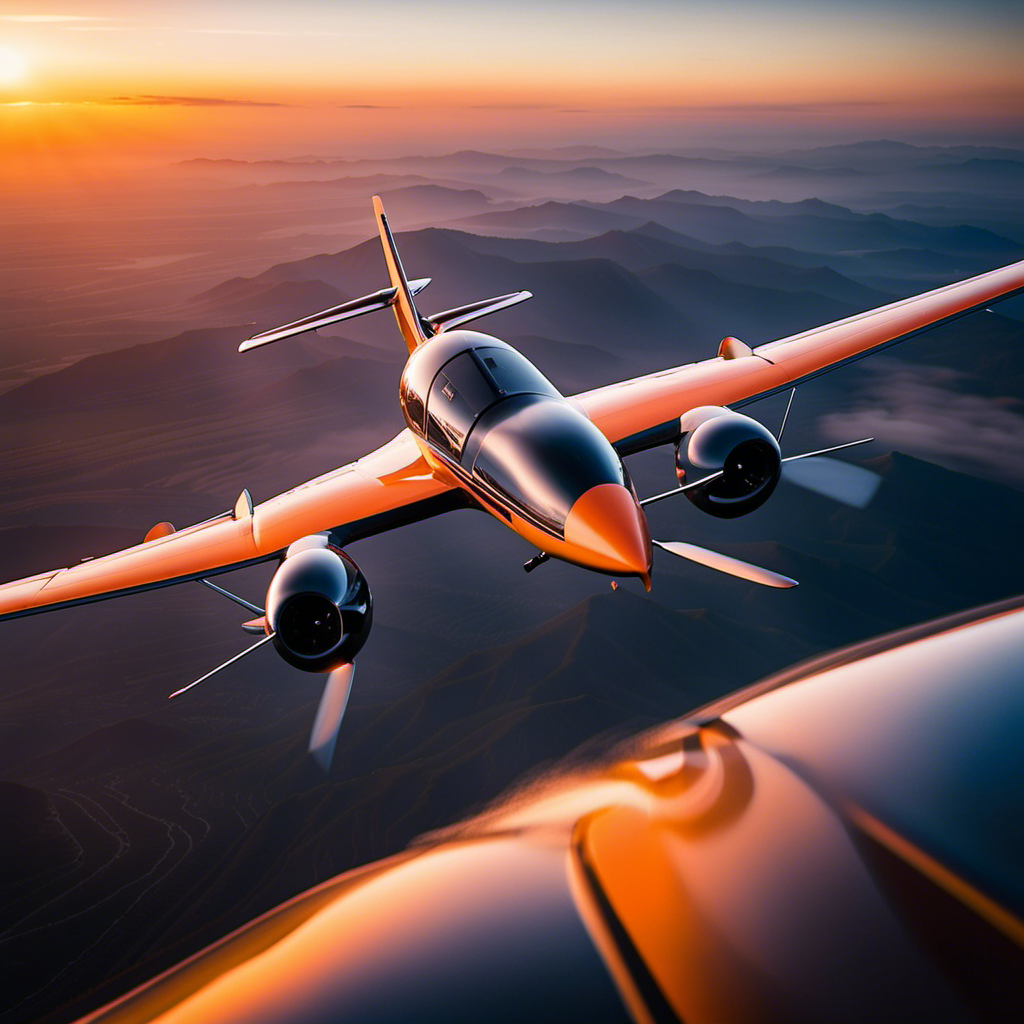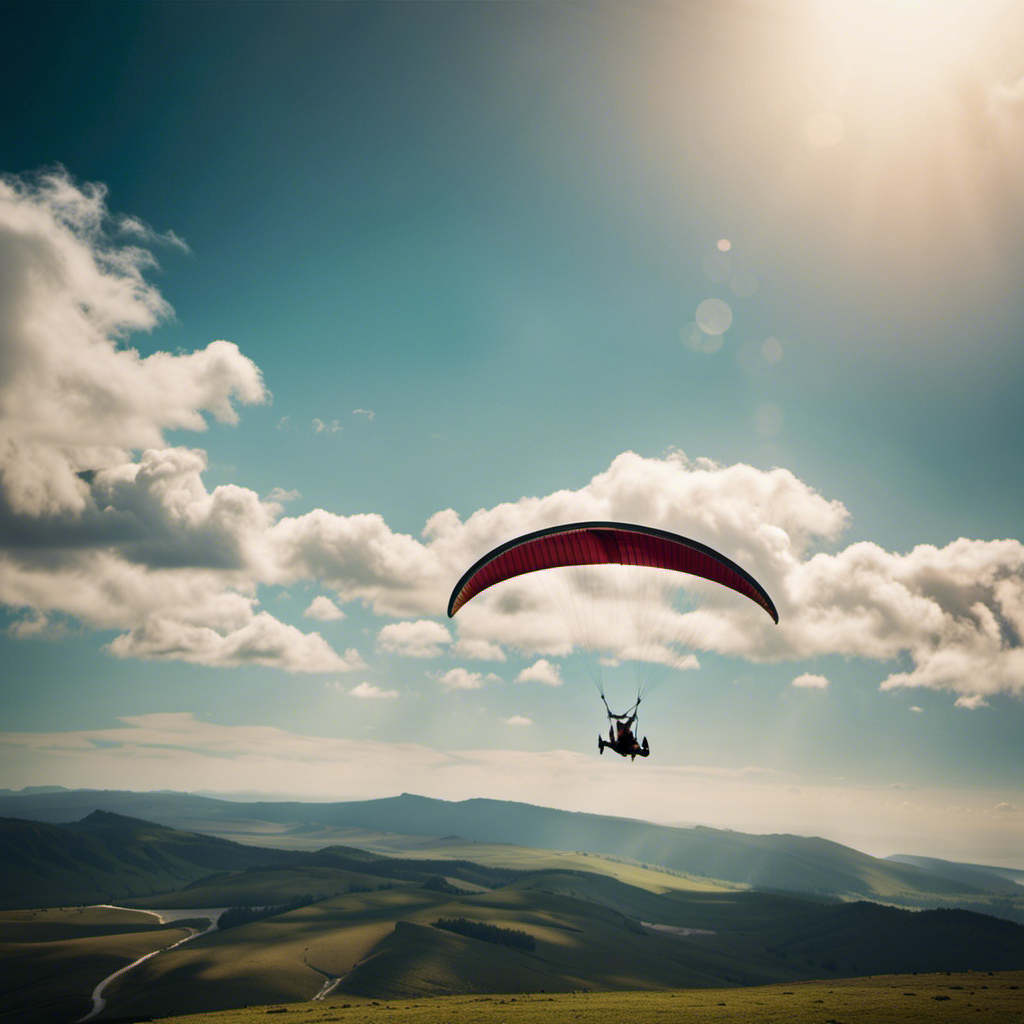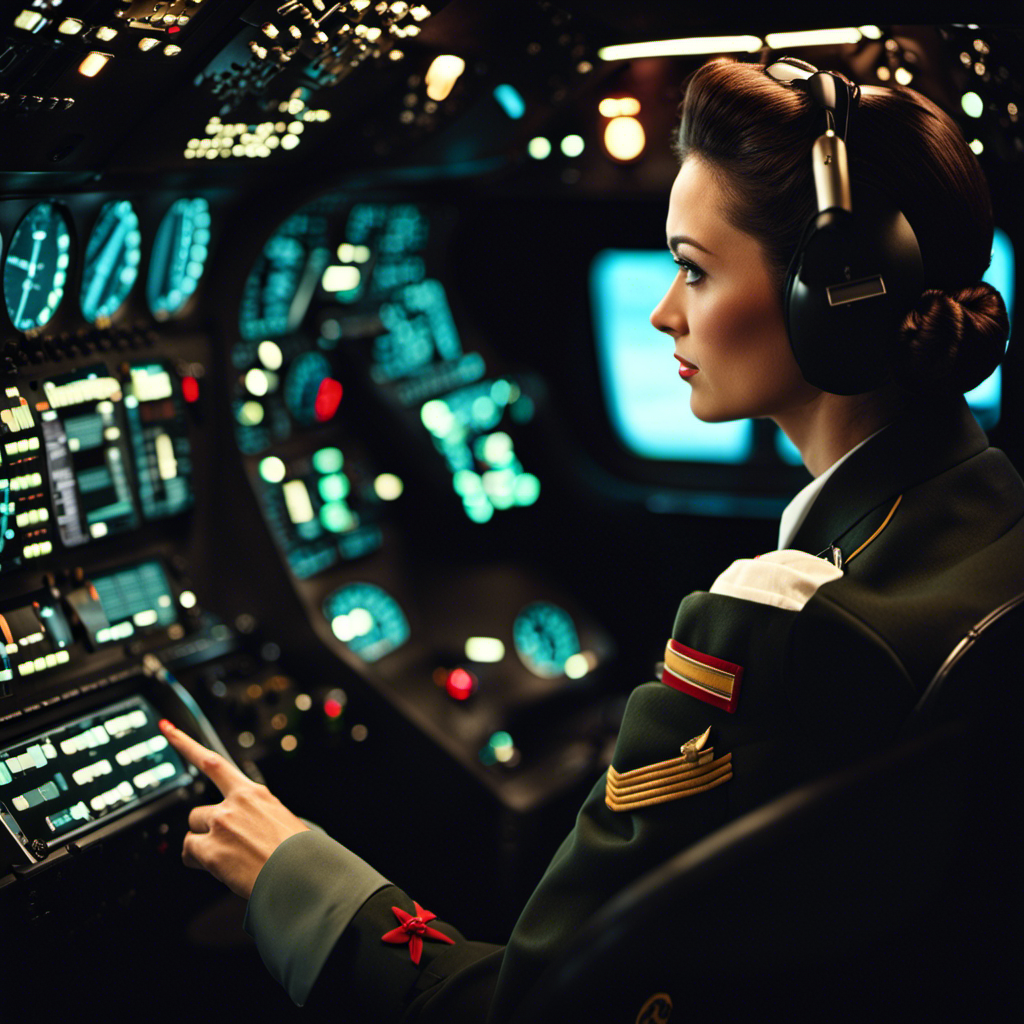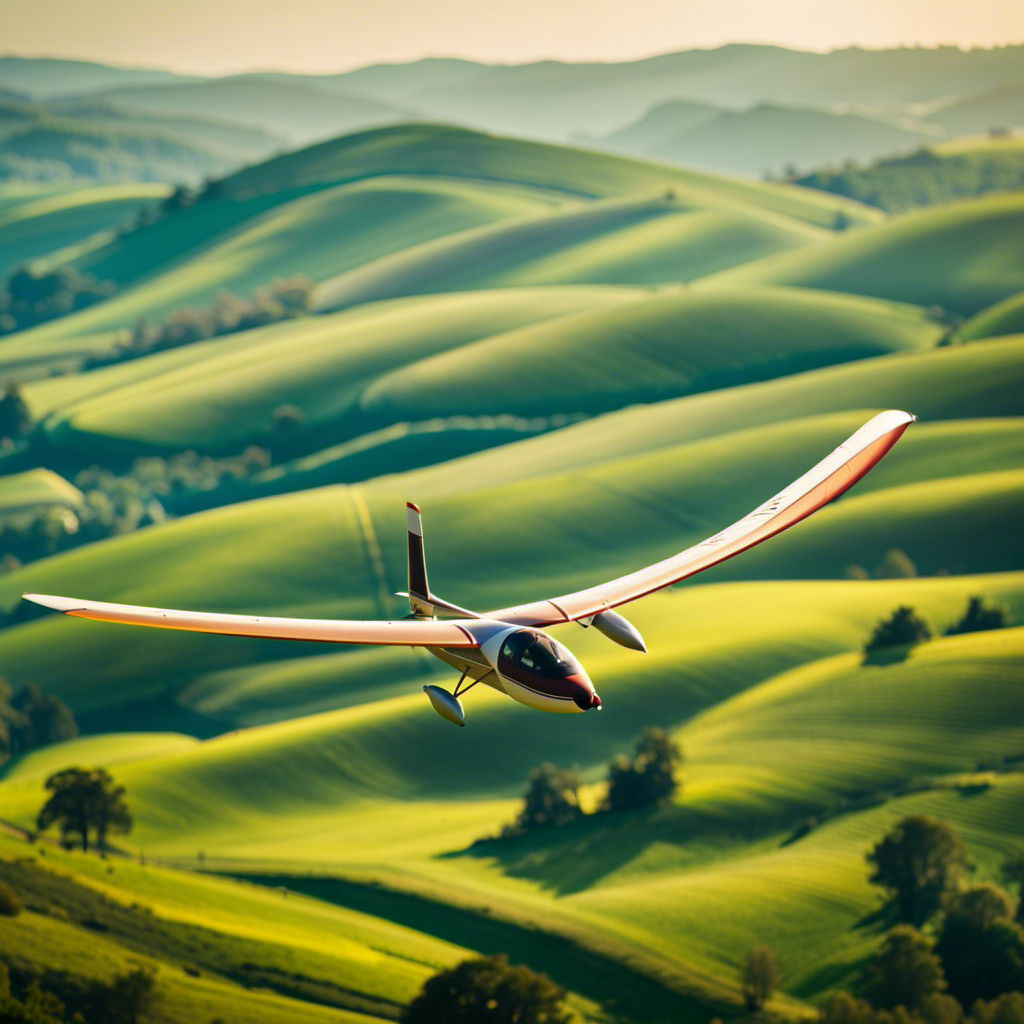As someone who pilots gliders, I remain endlessly captivated by the remarkable capability of these engineless aircraft to glide across the sky. It resembles observing a bird seamlessly soaring on thermal currents, seemingly challenging the force of gravity itself.
But have you ever wondered just how far a glider plane can glide? In this article, we will delve into the physics of gliding, the factors that affect glide distance, and even explore the longest recorded glider flights.
So buckle up, because we’re about to embark on a journey through the skies that will leave you in awe.
Key Takeaways
- Glider planes rely on natural forces like gravity and air currents for flight, as they have no engines.
- The design of glider planes, including wing shape and size, materials used, and weight and balance, greatly impacts their performance and glide ratio.
- Factors such as air currents, like thermals and ridge lifts, can provide additional lift for gliders, while turbulence can make flight more challenging.
- Glider pilots need to have skill in utilizing air currents and understanding factors like temperature, pressure, and terrain to optimize their gliding performance and maximize flight distance.
What is a Glider Plane?
Do you know what a glider plane is? Let me explain.
Glider planes, also known as sailplanes, are aircraft that rely solely on the natural forces of the atmosphere to stay airborne. Unlike powered planes, gliders have no engines, making them dependent on gravity and air currents.
The history of glider planes dates back to the late 19th century when Otto Lilienthal made significant advancements in glider design. Since then, gliders have evolved in their construction, with lightweight materials and streamlined shapes allowing for improved aerodynamic performance.
The wings of glider planes are designed to generate lift by exploiting the air’s flow over the curved surface. These principles of glider plane design are crucial in understanding the physics of gliding and how far these remarkable machines can glide.
The Physics of Gliding
As a pilot, it is crucial to understand the forces that enable glider planes to glide and how air currents affect glider flight. This understanding is essential for a successful and efficient flight.
Glider planes rely on two main forces for their gliding capabilities: lift and drag. Lift is generated by the motion of air over the wings. It is this force that keeps the glider in the air and allows it to stay aloft for extended periods. On the other hand, drag acts in the opposite direction, resisting the forward motion of the glider. Minimizing drag is important for maintaining speed and maximizing the glider’s range.
In addition to lift and drag, air currents also play a significant role in determining the glider’s path and speed. These currents can either provide an uplift or cause turbulence, both of which can greatly affect the glider’s overall flight performance. Uplifts, such as thermals and ridge lifts, can provide additional lift and help the glider gain altitude. Turbulence, on the other hand, can make the flight more challenging and less smooth.
Understanding how these forces and air currents interact is essential for a pilot to make informed decisions during a glider flight. By utilizing uplifts and avoiding turbulence, pilots can optimize their flight path and maximize their glider’s performance.
Forces that enable glider planes to glide
You can feel the lift generated by air flowing over the wings of a glider plane, allowing it to glide through the sky. Glider plane design and the aerodynamics of gliding play a crucial role in enabling this phenomenon.
The shape of the wings, known as airfoils, is carefully designed to produce lift. The airfoil’s curved upper surface and flatter lower surface create a pressure difference, resulting in an upward force. This lift opposes the force of gravity, allowing the glider to stay airborne.
Additionally, the glider’s streamlined body minimizes drag, further enhancing its gliding performance. Understanding these principles of glider plane design and the forces at play helps us appreciate the fascinating world of gliding.
Now, let’s explore how air currents affect glider flight, delving deeper into the dynamics of soaring through the skies.
How air currents affect glider flight
Air currents play a crucial role in determining the trajectory and speed of a glider’s flight. Understanding air current patterns and their impact on weather conditions is essential for glider pilots to maximize their flight performance. These patterns can be influenced by various factors such as temperature, pressure, and terrain. To better illustrate this, let’s take a look at the following table:
| Air Current Pattern | Impact on Glider Flight |
|---|---|
| Thermal | Provides lift for sustained flight |
| Ridge | Enables gliders to soar along mountain ridges |
| Wave | Creates powerful updrafts for extended altitude gain |
Analyzing these patterns allows pilots to strategically navigate the skies and optimize their glide distance. Transitioning into the subsequent section on factors affecting glide distance, we will explore how these air currents, along with other variables, contribute to the overall performance of a glider.
Factors Affecting Glide Distance
To maximize your glider plane’s glide distance, consider the factors affecting its performance. These factors play a crucial role in determining how far your glider can go. Here are the key factors to consider:
- Wing design: The shape and size of the wings greatly influence the glider’s lift and drag characteristics, which directly impact its glide distance.
- Weight: The lighter the glider, the better its glide performance. Excess weight increases drag and reduces efficiency.
- Glide ratio: This measures how efficiently the glider converts altitude into horizontal distance. A higher glide ratio means the glider can cover more ground.
- Pilot skill: The pilot’s ability to find and utilize thermals, updrafts, and other air currents can significantly extend the glider’s flight.
Understanding and optimizing these factors can help you achieve the longest possible glider flights. Moving on to the longest recorded glider flights…
Longest Recorded Glider Flights
The longest recorded glider flights have been achieved by skilled pilots who were able to harness thermals and other air currents effectively. These pilots have pushed the boundaries of glider flight, setting impressive records that have yet to be surpassed. In fact, the current record for the longest glider flight stands at an astounding 2,463.8 kilometers (1,530.1 miles).
This incredible feat was accomplished by Klaus Ohlmann and Uli Schwenk in 2003, flying a Schempp-Hirth Nimbus-4DM glider. Their flight took them from Germany to the Mediterranean Sea, demonstrating the remarkable endurance and capabilities of glider planes. The ability to exploit thermals, ridge lift, and wave lift allows pilots to travel vast distances without an engine, setting new milestones in glider flight records.
Transitioning into the subsequent section about ‘gliding competitions,’ these impressive glider flight records serve as a testament to the skill and determination of pilots in this competitive sport.
Gliding Competitions
After exploring the longest recorded glider flights, it is fascinating to delve into the world of gliding competitions. These events showcase the pinnacle of glider plane design and the mastery of gliding techniques.
In these competitions, pilots demonstrate their skill in navigating the air currents and maximizing the glider’s potential for distance. The design of a competitive glider plane prioritizes aerodynamic efficiency, with sleek wings, minimal drag, and precise control surfaces.
Pilots employ various gliding techniques such as thermaling, ridge soaring, and wave flying to gain altitude and extend their flight time. The objective is to cover the longest distance possible within a specific time window.
These competitions serve as platforms for innovation and development of new glider plane technologies, pushing the boundaries of what is achievable in gliding.
As we transition into discussing glider plane variations, we will further explore the diverse range of designs and features that improve gliding performance.
Glider Plane Variations
When it comes to glider planes, there are various types that offer distinct performance differences and capabilities.
Each type is designed with specific features and characteristics that allow for different types of gliding experiences.
Understanding these variations is crucial for pilots and enthusiasts alike, as it can greatly impact the overall performance and capabilities of the glider plane.
Different types of glider planes
There are various types of glider planes that can glide for different distances. Glider plane design and materials play a crucial role in determining their performance. Let’s take a look at the different types of glider planes:
| Type | Design Features | Materials |
|---|---|---|
| Traditional Glider | High aspect ratio wings for increased lift-to-drag ratio | Wood, fiberglass, or carbon fiber reinforced plastic |
| Motor Glider | Retractable engine for self-launching and extended range | Composite materials and aluminum alloy |
| Aerobatic Glider | Reinforced structure and aerodynamic enhancements | Carbon fiber composite materials |
Each type of glider plane is designed with specific features and uses different materials to optimize its performance. The traditional glider focuses on maximizing the lift-to-drag ratio, using materials like wood, fiberglass, or carbon fiber reinforced plastic. Motor gliders incorporate a retractable engine for self-launching and extended range, utilizing composite materials and aluminum alloy. Aerobatic gliders have a reinforced structure and aerodynamic enhancements, making use of carbon fiber composite materials. These design choices and material selections contribute to the gliders’ overall performance differences and capabilities, which we’ll explore further in the next section.
Performance differences and capabilities
When it comes to glider planes, understanding the different types available and their unique performance differences and capabilities is crucial. Here are four key factors that contribute to the performance differences among gliders:
-
Wing Design: The shape and size of the wings greatly impact the glider’s lift and glide ratio. High-performance gliders have sleek, aerodynamic wings that maximize lift and minimize drag.
-
Weight and Balance: Gliders vary in weight, which affects their overall performance. A lighter glider tends to have a better glide ratio, allowing it to cover more distance.
-
Control Systems: The efficiency and responsiveness of control systems, such as ailerons and elevators, directly impact the glider’s maneuverability and performance.
-
Structural Materials: The use of advanced materials, like carbon fiber, in the construction of glider planes improves their strength-to-weight ratio, enhancing their overall performance.
Understanding these performance differences and their historical significance allows us to appreciate the advancements in glider technology over time.
Now, let’s delve into the crucial safety measures for glider pilots.
Safety Measures for Glider Pilots
Glider pilots should always follow safety measures to ensure a safe flight. Adhering to safety regulations is paramount in this sport. Before takeoff, it is crucial to conduct a thorough pre-flight inspection, ensuring the glider is in optimal condition.
Pilots must also be well-versed in emergency procedures, such as how to handle a rope break or an in-flight emergency. Maintaining situational awareness is essential throughout the flight, as gliders often share airspace with other aircraft.
In the event of an emergency landing, pilots must be proficient in executing a safe and controlled descent. By diligently following these safety measures, glider pilots can mitigate risks and enjoy the thrill of soaring through the sky.
Transitioning to the next section, let’s explore the significance of gliding clubs and communities in fostering a supportive environment for glider enthusiasts.
Gliding Clubs and Communities
Joining a gliding club offers numerous benefits for pilots. Not only does it provide a community of like-minded individuals who share a passion for gliding, but it also offers valuable networking opportunities.
Through these connections, pilots can gain access to a wealth of knowledge, experience, and learning opportunities, allowing them to continually improve their skills and expand their horizons in the world of gliding.
Benefits of joining a gliding club
Being a member of a gliding club allows you to learn from experienced pilots and improve your skills. Joining a community of fellow glider enthusiasts provides numerous benefits, both in terms of socializing opportunities and knowledge acquisition.
Interacting with other club members allows you to share experiences, exchange ideas, and gain insights into the world of gliding. Networking with pilots who have years of experience can be invaluable in expanding your understanding of glider planes and honing your flying techniques.
Moreover, being part of a gliding club opens doors to social events and gatherings where you can meet like-minded individuals who share your passion for gliding. These interactions not only foster camaraderie but also provide a platform for continuous learning and growth.
As I delve deeper into the world of gliding, I am excited to explore the networking and learning opportunities that lie ahead.
Networking and learning opportunities
As a member of a gliding club, I can connect with experienced pilots and expand my knowledge and skills. Joining a gliding club opens up a world of networking opportunities and learning experiences.
Through interactions with seasoned pilots, I can gain valuable insights into various gliding techniques, weather patterns, and navigation strategies. These connections allow me to tap into a wealth of expertise and gather practical advice for improving my gliding abilities.
Additionally, being part of a gliding club provides access to workshops, seminars, and training programs that further enhance my understanding of glider technology and flying techniques. The exchange of ideas and experiences within the club fosters a continuous learning environment, helping us stay up to date with the latest advancements in gliding.
This network of like-minded individuals creates a supportive and collaborative community, enabling us to push the boundaries of glider technology and explore new possibilities in the future.
The Future of Glider Technology
The future of glider technology looks promising, with advancements in materials and design that will likely improve glide performance. Future advancements in glider technology will focus on sustainability measures, aiming to reduce the environmental impact of glider flights. This will involve the use of lightweight and eco-friendly materials in glider construction, as well as the integration of energy-efficient systems. By implementing these measures, gliders will be able to achieve longer and more efficient flights while minimizing their carbon footprint. Additionally, advancements in design will optimize aerodynamics and increase lift efficiency, allowing gliders to glide for even greater distances. The table below highlights some of the potential advancements in glider technology that will contribute to improved glide performance:
| Future Advancements | Sustainability Measures |
|---|---|
| Lightweight materials | Eco-friendly construction |
| Energy-efficient systems | Reduced carbon emissions |
| Optimized aerodynamics | Enhanced lift efficiency |
Conclusion and Personal Reflection
In conclusion, the future of glider technology holds great promise for the aviation industry.
As I reflect on my personal experience with gliders, I am astounded by the impact they have had on aviation.
Gliders have not only revolutionized the way we fly, but they have also pushed the boundaries of what was once thought possible.
The advancements in materials, design, and aerodynamics have allowed gliders to soar through the sky with unparalleled efficiency and grace.
This has not only made gliding more accessible to enthusiasts like myself, but it has also contributed to the development of more sustainable and environmentally-friendly aviation practices.
The future of glider technology is bright, and I am excited to see how it will continue to shape the world of aviation.
Frequently Asked Questions
Are glider planes powered or do they rely solely on gliding?
Glider planes rely solely on gliding and do not have any propulsion systems. Their flight is sustained through the principles of glider plane aerodynamics, utilizing air currents and the shape of the aircraft to maintain lift and extend their flight range.
How do glider pilots control the direction and speed of a glider plane?
I control the direction and speed of a glider plane using a combination of control surfaces and weight shifting techniques. By manipulating the ailerons, elevator, and rudder, I can maneuver the glider through the air like a skilled conductor guiding an orchestra. The principles of glider plane aerodynamics allow me to harness the forces of lift, drag, and gravity to maintain control and achieve the desired flight path.
Can a glider plane glide indefinitely or is there a limit to how long it can stay in the air?
There is a limit to a glider plane’s endurance in the air. Factors such as wind speed, altitude, and weight affect the gliding distance. However, with proper planning and skill, a glider can stay aloft for several hours.
What are the main differences between a glider plane and a traditional powered airplane?
The main differences between a glider plane and a traditional powered airplane are the lack of an engine in the glider, its reliance on thermals and wind currents for lift, and its ability to stay airborne for extended periods. Advantages include lower operating costs and a quieter flight experience, while disadvantages include the need for favorable weather conditions and limited maneuverability.
Are there any specific weather conditions that are ideal for gliding?
Ideal weather conditions for gliding involve strong, consistent winds, allowing gliders to soar effortlessly through the sky. Wind has a profound effect on glider planes, providing the necessary lift and allowing them to achieve remarkable distances.
Conclusion
In conclusion, the glider plane is a remarkable aircraft that can glide through the air with remarkable efficiency.
Through the analysis of the physics involved in gliding, we have discovered the factors that affect the glide distance of a glider plane.
From the longest recorded glider flights to the intense competitions among glider pilots, it is clear that the gliding community is passionate and dedicated.
As we look to the future, advancements in glider technology hold great promise.
In a nutshell, the sky is the limit for these soaring machines.
With a heart that soars as high as the skies, Aria, affectionately known as “Skylark,” is the driving force behind Soaring Skyways. Her journey into the gliding world began as a young dreamer gazing up at the soaring birds, yearning to experience the weightlessness and freedom they embodied. With years of experience both in the cockpit and behind the scenes, Aria’s commitment to the gliding community is unwavering.










